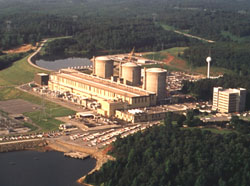|
Chemical
Leak Detected During Refueling of Oconee Nuclear Station
Paraphrased
by:
Steve Waldrop
May 1, 2003
Close to 100 workers beginning a routine refueling outage at Oconee Nuclear
Station's Unit 3 (South Carolina) were brought back out of the containment
building because of a potassium chromate leak, plant officials said.
 Potassium
chromate, a anti-corrosive used in one of the cooling systems in the building,
was found on a number of surfaces in the reactor containment building.
The anti-corrosive was contained inside the building and posses no danger
to people outside, said plant spokeswoman, Dayle Stewart. Potassium
chromate, a anti-corrosive used in one of the cooling systems in the building,
was found on a number of surfaces in the reactor containment building.
The anti-corrosive was contained inside the building and posses no danger
to people outside, said plant spokeswoman, Dayle Stewart.
Most of the workers were contract workers that specialize in refueling
outage work at nuclear plants across the United States. A few of the workers,
however, were employees of Duke Energy.
Before the workers were allowed to resume work, they were given added
protective equipment to wear, including double coveralls and respirators.
According to a Material Data Safety Sheet from the state Department of
Health and Environmental Control, potassium chromate is a strong oxidizer
and can cause severe burns on contact. It is harmful if swallowed or inhaled
and can affect the respiratory system, liver, kidneys, eyes, skin and
blood. It may cause an allergic reaction and can cause cancer.
None of the workers involved experienced any reactions or symptoms from
exposure, and the leak has been repaired, Stewart said.
Stewart went on to say that the actions taken to protect the workers were
"conservative" procedures and were based on the chemical manufacturer's
recommendations provided on a safety data sheet.
Spokesman for the Nuclear Regulatory Commission, Roger Hannah, said the
problem isn't radiation or nuclear safety issues and appears to have involved
no safety equipment. "It's more of an industrial safety issue,"
Hannah said.
The leakage poses no problem to the general public, Hannah said. The chemical
is considered a "negligible fire hazard," and explosion or fire
resulting from the leakage is highly unlikely.
The Material Safety Data Sheet shows that the pure compound isn't combustible,
but contact with certain substances or heat could cause fire or explosion.
Stewart said fire or explosion is unlikely because of the small amount
of the substance and because there's no danger of contact with incompatible
materials in the building's controlled environment.
|

